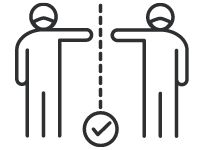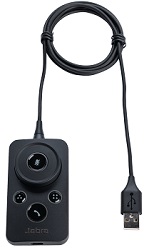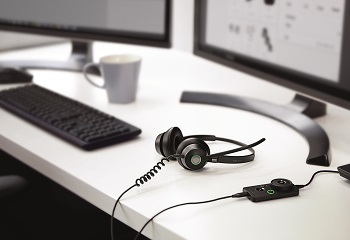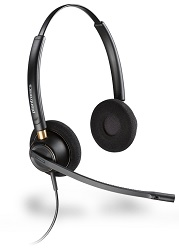There were 15 posts tagged: Contact Center
Train with wireless headsets and maintain social distancing
The COVID-19 pandemic has fundamentally changed the work place: some were sent home to work and will stay there; others working in the office have new rules to follow.
To limit virus spread, the CDC recommends limited face-to-face contact. As people return to the office, the CDC-recommended social distancing, also called “physical distancing,” (keeping a safe space between yourself and other people who are not from your household) is in effect. To practice this distancing, workers must stay at least 6 feet (about 2 arms’ length) from others.
 For call centric employees, side by side training is a necessity; yet, how can we accomplish this in the office, at a safe distance?
For call centric employees, side by side training is a necessity; yet, how can we accomplish this in the office, at a safe distance?
Fortunately, the technology in most DECT wireless headsets allows "call conferencing" between units. This is a great feature that allows employees to drop into calls for training or conference call purposes, with minimal contact.
1. Remove the primary/host headset from the base.
2. Drop the secondary/guest headset into the headset cradle. The host headset will hear a tone to accept the new headset. The host headset will click the "Answer/End" button.
3. Remove the guest headset from the host base. The headsets are now paired and ready to work together. This process can be repeated for an additional 2 headsets, for a total of 4 headsets on the same call.
4. The guest headset can be muted for listening purposes; simply unmute if necessary.
5. To end the conference/pairing feature, press the End button on the primary/host headset. It's that simple!
If you deploy corded headsets to your employees, you’ll want to explore options beyond traditional side by side training. Perhaps your current softphone solution offers listen-in type features that you can take advantage of for training purposes.
For questions about wireless headsets in the contact center environment, or suggestions for the best wireless headsets for your unique set-up, call our Headset Experts at 1-866-998-9991 or Chat us now!
To limit virus spread, the CDC recommends limited face-to-face contact. As people return to the office, the CDC-recommended social distancing, also called “physical distancing,” (keeping a safe space between yourself and other people who are not from your household) is in effect. To practice this distancing, workers must stay at least 6 feet (about 2 arms’ length) from others.
 For call centric employees, side by side training is a necessity; yet, how can we accomplish this in the office, at a safe distance?
For call centric employees, side by side training is a necessity; yet, how can we accomplish this in the office, at a safe distance?Fortunately, the technology in most DECT wireless headsets allows "call conferencing" between units. This is a great feature that allows employees to drop into calls for training or conference call purposes, with minimal contact.
Call training is easy — and safe — when you use wireless headsets.
Here's how:1. Remove the primary/host headset from the base.
2. Drop the secondary/guest headset into the headset cradle. The host headset will hear a tone to accept the new headset. The host headset will click the "Answer/End" button.
3. Remove the guest headset from the host base. The headsets are now paired and ready to work together. This process can be repeated for an additional 2 headsets, for a total of 4 headsets on the same call.
4. The guest headset can be muted for listening purposes; simply unmute if necessary.
5. To end the conference/pairing feature, press the End button on the primary/host headset. It's that simple!
If you deploy corded headsets to your employees, you’ll want to explore options beyond traditional side by side training. Perhaps your current softphone solution offers listen-in type features that you can take advantage of for training purposes.
For questions about wireless headsets in the contact center environment, or suggestions for the best wireless headsets for your unique set-up, call our Headset Experts at 1-866-998-9991 or Chat us now!
Jabra Engage 50 digital corded headsets
 Five years ago, it was proclaimed that customers would no longer call into businesses; that they would prefer to find support via email, social and Chat channels, and organizations scrambled to train and ramp up those areas in their call centers (updating the terminology to "contact centers").
Five years ago, it was proclaimed that customers would no longer call into businesses; that they would prefer to find support via email, social and Chat channels, and organizations scrambled to train and ramp up those areas in their call centers (updating the terminology to "contact centers").Yet, here it is, almost 2020, and it turns out, customers are still calling businesses when they need help. Research has shown that customers start with online assistance for simple questions; however, as matters become more complicated, phone calls remain the preferred way to contact companies. This means that customer service agents are expected to know more detailed information and handle longer, complex calls. The pressure to produce results in a cost-efficient manner means that data analytics are crucial.
With this in mind, Jabra engineered a headset that meets these needs by offering digital sound, data analytics, Busylights on the ear speakers, and is comfortable to wear through long, demanding calls. The Engage 50 corded headset is available in both Mono and Duo versions and ends in USB-C. The generous-sized leatherette ear cushions have a conical design, so that the cushions rest securely on the ear.
How is the Engage 50 a Digital Headset?
A processing chip in the headset — rather than in a control unit or cord — makes the Engage 50 a digital headset. While most wireless headsets are already digital headsets, the Engage 50 is the first Jabra corded headset to have the chip in the headset itself. The Engage 50 uses the very latest chipset, and this, along with the positioning of the chip, delivers enhanced functionality and user experience. Along with Jabra Direct and Jabra Xpress, call analytics for the business, and on-screen microphone positioning guidance for the agents, are provided. A great headset, along with Jabra software, improves customer satisfaction.
and Jabra Xpress, call analytics for the business, and on-screen microphone positioning guidance for the agents, are provided. A great headset, along with Jabra software, improves customer satisfaction.
Engage 50 Link Control Unit
The control unit improves call control and the ergonomic design helps agents work more efficiently. It is an optional accessory; however, it must be purchased in order to use the Engage 50 with USB-A ports. There are four variations of the control unit:Jabra Engage 50 Link USB-A
Jabra Engage 50 Link USB-A Microsoft certified
Jabra Engage 50 Link USB-C
Jabra Engage 50 Link USB-C Microsoft certified
Data analytics and free Jabra software
Jabra Xpress 2.0 is designed for IT professionals to 100 percent remotely manage Jabra USB headsets and speakerphones with a set of smart tools. Xpress keeps different devices, across multiple locations and with numerous users, always updated with the latest firmware. Xpress offers easy mass deployment and agile maintenance. It works no matter the platform you work with, or whether you’re working from your own premises, your own cloud-based service, or the Jabra cloud. And, call analytics received from individual headset users help your management team make data-based decisions to improve agent productivity and the customer call experience. These comprehensive insights include background noise, speech analytics, headset usage analytics and audio exposure.
It works no matter the platform you work with, or whether you’re working from your own premises, your own cloud-based service, or the Jabra cloud. And, call analytics received from individual headset users help your management team make data-based decisions to improve agent productivity and the customer call experience. These comprehensive insights include background noise, speech analytics, headset usage analytics and audio exposure.Jabra Direct is a user-friendly desktop interface offering complete integration of your softphone and headset. The Jabra Direct dashboard is a user friendly status menu available from the desktop notification area, typically accessed via the lower right corner of the desktop.The dashboard shows the status of your headset, if any updates are available, and if your softphone(s) are ready for use. By clicking your Jabra device in the dashboard, you will be linked into the Jabra Direct main application for managing setting preferences, start firmware updates or access applications that are available for your headsets.
And did we mention, these software programs are available at no cost, for both Mac and Windows platforms?
To learn more about Jabra Engage 50 headsets, call our Headset Experts at 1-866-998-9991.
Will Video Conferencing make you regret referring to your contact center as ‘multi-channel’? Consider these issues.
A guest post by Mike Dershowitz, the CEO of Rethink Staffing, a Fair Trade Outsourcing Company, and its sister facility, RTS Philly Outsourcing Center. He believes that when companies focus on their employees’ social and economic progress, it motivates them to perform better at work and produce outperforming results. Contact him at 888-631-0398 or mike@rethinkstaffing.com for an initial consultation. Read more from Mike on his Medium site.
Original publish date: September 3, 2018
As much as the contact center world is deploying AI and bots, like any other business, to optimize its operations with existing humans, or someday replace them, there has been a parallel, growing body of practice known as “Video consumer Service” that is quietly changing our industry as well.
With broadband almost everywhere now, video conferencing has come into the mainstream and is used by many business professionals almost on a daily basis. A 2017 study by IHS Markit stated that 85% of companies surveyed use video conferencing as part of their unified communications environment.
 Make no mistake, video consumer service could be coming to your contact center. Video consumer service gives us a fascinating window, not only into the future, but also into a world where “phone etiquette” is insufficient, and a place where bots will not be able to go for decades, if ever.
Make no mistake, video consumer service could be coming to your contact center. Video consumer service gives us a fascinating window, not only into the future, but also into a world where “phone etiquette” is insufficient, and a place where bots will not be able to go for decades, if ever.At Rethink Staffing, one of our earliest consumers was a company with a pure Video Consumer Service need. While we do handle their regular multi-channel support, their video consumer service staff is twelve times the size of their multi-channel staff. For their business, Video is consumer service.
Asked whether or not we could do this, our answer was “absolutely,” and we had a handful of early Agents who were game. But once we got started, there were a host of issues we definitely had to worry about, for which neither we nor our client was prepared for.
For the uninitiated, video consumer service is simply rendering a consumer service session via video, where you can see the consumer, and your consumers can see you, and interact with you through a microphone, speakers and a webcam. While not for everyone, you’d be surprised how many consumers find it a viable option.
In preparation for the day when a video consumer opportunity may be at your doorstep, here’s a small list of things to consider if one of these comes across your desk:
First up? “Eyelines.” When your consumers can see your agents via video, it’s a whole new ball game about what your contact center actually looks like. The consumer will care, and comment, about what they see. Embarrassment ensues, like the time we inadvertently positioned an agent’s desk in front of the door to the men’s room without realizing it. Luckily all the consumer saw was hands being washed before we caught that mistake and corrected it.
Second: “New Etiquette.” We had to re-write the rules here, on both sides. What shocked us most was how some agents became lax in their behavior on camera, in many cases without noticing it. Like the time that a consumer who went to retrieve a piece of information, and our Agent decided now was a good time to brush her hair, and reapply makeup, and continued to do so when the consumer returned.
Third: “Connection.” Connection and computer speeds at your consumer’s point of contact will vary greatly. While the software for video consumer service should validate your consumer’s technology, this will impact the way your Agents render service. They have to be on the lookout for pauses, echoes, and other impediments to smooth communication. Think back to the early days when we started getting calls from consumers on mobile phones.
Fourth: “Thick Skin.” We had to retrain folks on what they could expect to see from those outlier consumers. No longer were we worried about sarcastic comments, profanity, or yelling. Now, we had to worry about the visual side of all of that, as well as a window into consumer’s lives that turned early agents into enthusiastic voyeurs.
And then there was the time when the Agent, confronted with an attractive member of the opposite sex on their video screen, tried to end the call by getting a date.
In the beginning, while it was certainly an entertaining and a profound window into the human psyche, the video feed ended up normalizing Agent behavior, once they were made aware, much faster than the phone does. Simply put, the human psychological need for esteem and not to be embarrassed turned out to be our biggest ally in creating professional behavior while on video.
Also, it’s important to not neglect the IT issues here. Forget about just good webcams and microphones — that’s table stakes. Your IT department has to worry about massively greater bandwidth consumption, redundancy, congestion, as well as packet routing.
Finally, the intimacy of video is so much greater than the phone; 90% of all human communication is nonverbal. The upside to video consumer service is that when it’s good, your agents feel much better about helping their consumers and the thanks they receive make a much larger impact on them.
So, if you see a video consumer service application come across your desk, I say go for it. If nothing else, it will be challenging and fun. Just make sure you’re prepared for what you’re getting yourself into!
Why Scripts Don't Always Work
One of our employees received a personal message a few months back from an acquaintance who had started a new business: “Hey! Hope all is well! I am reaching out as I have recently joined [Company X]. Let me ask a few questions: are you currently using any face wash, do you have any dark marks, acne, fine lines/wrinkles, or sensitive skin? If you currently have a skincare regimen that you love, great! If you are looking for a new one or don’t have one (or even looking to even out your skin tones), let’s talk more. I would love to tell you more about [Company X] and would love your support in my new business endeavor.”
When our reply was “Congratulations on your new venture, we too love this brand and have been using it for a year” there was no reply. Not even a “Darn! Wish I was able to help you” or a “Way to go! You chose the right products!” We were a bit surprised by this and it then became very obvious that this new business person simply sent out a blanket message that was scripted from her company, with no thought beyond the initial message. Keep in mind, this person is a new Brand Ambassador for this company and a face of these products, and while surely disappointed in our reply, a quick response would have gone far in keeping a positive impression of this brand.
Wish I was able to help you” or a “Way to go! You chose the right products!” We were a bit surprised by this and it then became very obvious that this new business person simply sent out a blanket message that was scripted from her company, with no thought beyond the initial message. Keep in mind, this person is a new Brand Ambassador for this company and a face of these products, and while surely disappointed in our reply, a quick response would have gone far in keeping a positive impression of this brand.
This got us to thinking about scripts in general. A script enables quick communication and can be useful in some situations. Learning a new job can be overwhelming; providing sales scripts can be one of the ways to ease the burden of learning everything all at once. A framework and guidance in situations where nerves may get the best of you provide some peace of mind.
However, there are times when scripts are not useful, appropriate or well-planned. Interacting with others should be a natural process and not "forced." What happens when the other person doesn't answer the way the script says they should? Then what? Continuing to go down the path that the script lays out can be frustrating and counterproductive for both parties. Knowing when to go "off-script" is critical in building relationships. This values everyone's time throughout the process. Another key is to be sure to round out the conversation and always provide a genuine response.
When our potential customer doesn’t reply as we would hope they would (and let’s face it, this happens daily), let’s be sure we’ve formulated a plan of action for these types of responses and not leave the customer to think we don’t care. This is going to require a more natural, human response. I think we can all handle that, right?
When our reply was “Congratulations on your new venture, we too love this brand and have been using it for a year” there was no reply. Not even a “Darn!
 Wish I was able to help you” or a “Way to go! You chose the right products!” We were a bit surprised by this and it then became very obvious that this new business person simply sent out a blanket message that was scripted from her company, with no thought beyond the initial message. Keep in mind, this person is a new Brand Ambassador for this company and a face of these products, and while surely disappointed in our reply, a quick response would have gone far in keeping a positive impression of this brand.
Wish I was able to help you” or a “Way to go! You chose the right products!” We were a bit surprised by this and it then became very obvious that this new business person simply sent out a blanket message that was scripted from her company, with no thought beyond the initial message. Keep in mind, this person is a new Brand Ambassador for this company and a face of these products, and while surely disappointed in our reply, a quick response would have gone far in keeping a positive impression of this brand.This got us to thinking about scripts in general. A script enables quick communication and can be useful in some situations. Learning a new job can be overwhelming; providing sales scripts can be one of the ways to ease the burden of learning everything all at once. A framework and guidance in situations where nerves may get the best of you provide some peace of mind.
However, there are times when scripts are not useful, appropriate or well-planned. Interacting with others should be a natural process and not "forced." What happens when the other person doesn't answer the way the script says they should? Then what? Continuing to go down the path that the script lays out can be frustrating and counterproductive for both parties. Knowing when to go "off-script" is critical in building relationships. This values everyone's time throughout the process. Another key is to be sure to round out the conversation and always provide a genuine response.
When our potential customer doesn’t reply as we would hope they would (and let’s face it, this happens daily), let’s be sure we’ve formulated a plan of action for these types of responses and not leave the customer to think we don’t care. This is going to require a more natural, human response. I think we can all handle that, right?
Happy Employees Equal Happy Customers
 Our contact center staff is on the front lines every day. Plantronics uses the term “Brand Ambassadors,” as these staff members are the face of your company to the outside world. They are the first, and sometimes final, point of contact for customers.
Our contact center staff is on the front lines every day. Plantronics uses the term “Brand Ambassadors,” as these staff members are the face of your company to the outside world. They are the first, and sometimes final, point of contact for customers.We are in the middle of the “most wonderful time of the year“ and you are probably looking around your call center right now and wondering if you’ve done everything you possibly could have to ensure a successful, positive holiday season for your staff, and in turn, for your customers. Long hours, sleep-deprived customers and staff, and faulty equipment can contribute to poor morale.
Whether you are at this point in the year completely immersed in the holiday season in your contact center, or just gaining steam, one of the most
 important pieces of equipment your staff uses is their headset. Are they working with broken-down, pieced-together-with-Scotch-tape headsets? Or, are you equipping them with a quality headset that’s comfortable and one they feel confident with using every day?
important pieces of equipment your staff uses is their headset. Are they working with broken-down, pieced-together-with-Scotch-tape headsets? Or, are you equipping them with a quality headset that’s comfortable and one they feel confident with using every day?Our recommendation for staff members who are on the phone for the majority of their work day: the Plantronics EncorePro HW520. Plantronics took the best from the SupraPlus family and updated the technology, fit and comfort level into a stylish, lightweight headset with high quality sound.
Why Should You Choose the EncorePro HW520?
- Lightweight
- Adjustable fit
- Laser-welded construction: Aircraft-grade aluminum joints
- Dual ear cushions completely cover the ears for total immersion in calls.
- Large, soft foam ear cushions (Leatherette cushions an optional purchase).
- Noise-cancelling microphone
- Flexible boom with visual and tactile positioning guides for precise positioning and clear conversations/voice clarity
- Compliant with OSHA/Noise at Work regulations
- SoundGuard (acoustic limiting technology present in all headsets from Plantronics that protects against sounds above 118dBA)
Enjoy a wonderful holiday season, a productive staff, and happy customers, with the help of new Plantronics EncorePro headsets! Happy Holidays!

